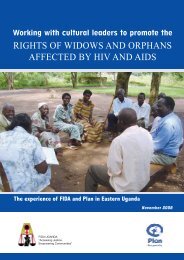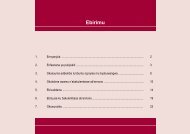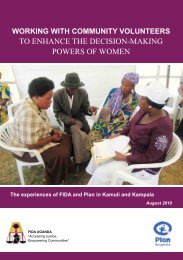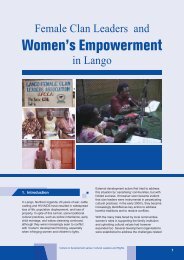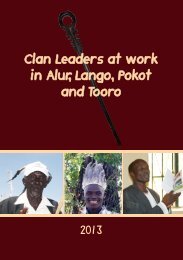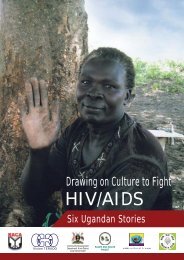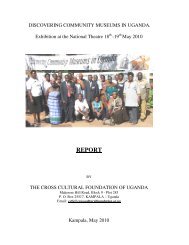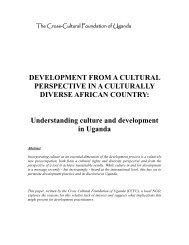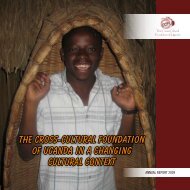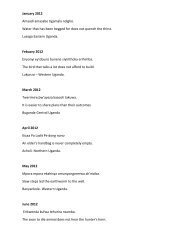Community Museums in Uganda - Cross-Cultural Foundation of ...
Community Museums in Uganda - Cross-Cultural Foundation of ...
Community Museums in Uganda - Cross-Cultural Foundation of ...
Create successful ePaper yourself
Turn your PDF publications into a flip-book with our unique Google optimized e-Paper software.
“If we do not save our heritage for<br />
our children, who will?”<br />
<strong>Community</strong><br />
<strong>Museums</strong> <strong>in</strong> <strong>Uganda</strong><br />
CCFU, 2012
Marriage bangle, Human Rights Focus Peace Museum, Gulu.<br />
Cover (clockwise from top left): Div<strong>in</strong>er’s stick, <strong>Uganda</strong> Martyrs University Museum, Nkozi; Wooden conta<strong>in</strong>er, Edirisa Museum,<br />
Kabale; Model hut, <strong>Cultural</strong> Assets Centre, Kibaale.
Table <strong>of</strong> Contents<br />
1 Heritage – an evolv<strong>in</strong>g perception<br />
2 <strong>Uganda</strong>’s culture – a grow<strong>in</strong>g appreciation<br />
3 <strong>Community</strong> museums <strong>in</strong> <strong>Uganda</strong><br />
4 Contribut<strong>in</strong>g to national development<br />
5 The journey <strong>of</strong> the <strong>Cross</strong>-<strong>Cultural</strong> <strong>Foundation</strong><br />
with community museums<br />
6 Our cultural heritage: a collective responsibility<br />
Decorated gourd for protection spirit,<br />
St Luke Museum, Kyotera.
1 Heritage – an evolv<strong>in</strong>g perception<br />
<br />
For many years, museums the world over were seen as<br />
<strong>in</strong>stitutions to be treated with the utmost respect, where<br />
visitors would admire <strong>in</strong> silence well-guarded objects on<br />
display. One’s national heritage <strong>of</strong>ten found its expression <strong>in</strong><br />
artefacts carefully presented <strong>in</strong> glass boxes, exhibited thanks to<br />
public funds or the generosity <strong>of</strong> rich patrons.<br />
From the 1980’s, conservation and the role <strong>of</strong> museums were<br />
redef<strong>in</strong>ed. The perception <strong>of</strong> heritage moved away from artefacts and<br />
monuments alone to <strong>in</strong>clude ‘liv<strong>in</strong>g museums’ and the ‘<strong>in</strong>tangible’<br />
heritage: the body <strong>of</strong> knowledge, traditions, customs, skills, even<br />
values, that are so important <strong>in</strong> def<strong>in</strong><strong>in</strong>g peoples, communities and<br />
nations, and without which the physical aspects <strong>of</strong> one’s heritage<br />
are devoid <strong>of</strong> much mean<strong>in</strong>g. Tourism - <strong>in</strong>clud<strong>in</strong>g cultural tourism<br />
- also emerged as a major <strong>in</strong>ternational <strong>in</strong>dustry; ‘heritage’ became<br />
part <strong>of</strong> modern economies and <strong>in</strong>creas<strong>in</strong>gly driven by private sector<br />
<strong>in</strong>itiatives. At the same time, the need to protect the environment<br />
and to use resources susta<strong>in</strong>ably became a grow<strong>in</strong>g global concern.<br />
With this evolution, punctuated by a series <strong>of</strong> UNESCO Conventions,<br />
the ‘people dimension’ <strong>of</strong> heritage has become more prom<strong>in</strong>ent,<br />
as well as the connection between heritage and development –<br />
<strong>in</strong>clud<strong>in</strong>g <strong>in</strong> low <strong>in</strong>come countries. Heritage is therefore <strong>in</strong>creas<strong>in</strong>gly<br />
seen as <strong>in</strong>volv<strong>in</strong>g all sectors <strong>of</strong> society. We have moved well away<br />
from the elitist concept <strong>of</strong> a few decades ago.<br />
These trends are reflected <strong>in</strong> <strong>Uganda</strong>, as this publication focus<strong>in</strong>g<br />
on people’s efforts to protect and promote their heritage,<br />
demonstrates.<br />
In 2009, the <strong>Cross</strong>-<strong>Cultural</strong> <strong>Foundation</strong> <strong>of</strong> <strong>Uganda</strong>, a local NGO,<br />
launched an <strong>in</strong>itiative to “L<strong>in</strong>k past and future: People’s museums<br />
and cultural resource centres <strong>in</strong> <strong>Uganda</strong>.” Rather than focus<strong>in</strong>g<br />
on Government museums (that are <strong>of</strong>ten divorced from ord<strong>in</strong>ary<br />
people), this concerns community museums, whose existence is<br />
less well known, but where an attempt has been made by local<br />
organisations or <strong>in</strong>dividuals to connect past and future.<br />
CCFU is keen to support these efforts, as a means to harness<br />
cultural specificity and diversity for development, and to strengthen<br />
<strong>Uganda</strong>’s national cultural consciousness. This publication is meant<br />
to highlight these museums and to encourage readers to support<br />
them, especially by pay<strong>in</strong>g them a visit…
Model hut –Karamoja Women’s <strong>Cultural</strong> Group Museum, Moroto
A passion for heritage:<br />
Festo Karwemera, Edirisa<br />
Museum, Kabale<br />
<br />
“Before I was sent to school <strong>in</strong> 1936, my mother took me to a shr<strong>in</strong>e,<br />
placed my hand on top <strong>of</strong> a pot <strong>of</strong> local beer and told me to chant<br />
the follow<strong>in</strong>g words after her: “Now that I am go<strong>in</strong>g to battle, I pray<br />
that I come back successfully.” I <strong>in</strong>terrupted her with a question:<br />
“Who are we talk<strong>in</strong>g to?” She told me not to worry, but to cont<strong>in</strong>ue<br />
chant<strong>in</strong>g after her, which I obediently did. She cont<strong>in</strong>ued <strong>in</strong>ton<strong>in</strong>g.<br />
“Keep me safe from sickness and give me life”<br />
“Many years later, when I had become a teacher, I began to th<strong>in</strong>k twice<br />
about my mother’s prayer to I-did-not–know-whom. If my mother<br />
was talk<strong>in</strong>g about me hav<strong>in</strong>g life and be<strong>in</strong>g successful, she certa<strong>in</strong>ly<br />
could not have been pray<strong>in</strong>g to Satan. While the missionaries thought<br />
we worshipped Satan, I strongly feel that we were worshipp<strong>in</strong>g a<br />
supernatural God whom we believed <strong>in</strong>. In 1927, the colonialists<br />
and the chiefs burnt down all the shr<strong>in</strong>es, claim<strong>in</strong>g that they were<br />
devilish. Our behaviour changed because <strong>of</strong> the missionaries.<br />
“I decided to build this Museum for our children and grand children,<br />
to teach the future generation about the past. I have not put anyth<strong>in</strong>g<br />
Western <strong>in</strong> the Museum. Young people come and are taken around.<br />
Wooden conta<strong>in</strong>er, Edirisa<br />
Museum, Kabale
2 <strong>Uganda</strong>’s culture – a grow<strong>in</strong>g<br />
appreciation<br />
When <strong>Uganda</strong> secured its <strong>in</strong>dependence <strong>in</strong> 1962, a nascent<br />
tourism <strong>in</strong>dustry focused on national parks. A few<br />
monuments and build<strong>in</strong>gs were listed and protected. Our<br />
national museum - exhibit<strong>in</strong>g ‘tribal’ lore and natural history - had<br />
recently moved to its current, grand premises. It was a build<strong>in</strong>g<br />
ahead <strong>of</strong> its time, exhibit<strong>in</strong>g much confidence <strong>in</strong> the future. The<br />
value <strong>of</strong> Kasubi tombs and the Nyero rock pa<strong>in</strong>t<strong>in</strong>gs was recognised,<br />
and a small district museum was <strong>in</strong> existence <strong>in</strong> Soroti.<br />
As the country entered its turbulent political period, this optimism<br />
vanished. Heritage protection and tourism seem<strong>in</strong>gly went <strong>in</strong>to<br />
oblivion until the late 1990’s. It was also a time when culture<br />
<strong>of</strong>ten came to be dismissed as dance and drama, or as backward<br />
and irrelevant to a ‘modern’ society. As somewhat said, ‘culture<br />
does not br<strong>in</strong>g food on the table’. The 1990’s also showed that<br />
the forces <strong>of</strong> globalisation <strong>of</strong>ten threaten <strong>Uganda</strong>’s culture: its<br />
social fabric and values seem to be evolv<strong>in</strong>g <strong>in</strong> ways that many do<br />
not approve <strong>of</strong>.<br />
Today, we nevertheless f<strong>in</strong>d that certa<strong>in</strong> forms <strong>of</strong> <strong>Uganda</strong>’s culture<br />
are very resilient. These are however rarely exploited for progress.<br />
Generally, development prescriptions neglect the country’s cultural<br />
dimensions and rich diversity and, as a nation, we do not give a<br />
high priority to cultural affairs. After all, we do not even have a
fully fledged M<strong>in</strong>istry <strong>of</strong> Culture! Our National Culture Policy<br />
generally rema<strong>in</strong>s a dormant document, with hardly any f<strong>in</strong>anc<strong>in</strong>g.<br />
And everywhere our built heritage is vanish<strong>in</strong>g before our eyes,<br />
unprotected by outdated laws or ravaged, such as the Kasubi tombs<br />
fire, because <strong>of</strong> poor safety measures. The old must be replaced by<br />
the new and sh<strong>in</strong>y, and there is even talk <strong>of</strong> demolish<strong>in</strong>g our one<br />
and only National Museum…<br />
But th<strong>in</strong>gs are chang<strong>in</strong>g: we <strong>in</strong>creas<strong>in</strong>gly recognise that ‘heritage’<br />
goes beyond the gorillas <strong>in</strong> Bw<strong>in</strong>di forest or our spectacular<br />
landscapes. Local languages have been re-<strong>in</strong>troduced as a medium <strong>of</strong><br />
<strong>in</strong>struction <strong>in</strong> primary schools. Tourism is <strong>in</strong>creas<strong>in</strong>g its contribution<br />
to the national economy. A new museum has been built <strong>in</strong> Karamoja<br />
and steps are be<strong>in</strong>g taken to reconstruct Kasubi tombs, a UNESCO<br />
World Heritage Site. There is a grow<strong>in</strong>g realisation that our heritage<br />
lies <strong>in</strong> our people – <strong>in</strong> other manifestations <strong>of</strong> our tangible heritage,<br />
as well as the wealth and diversity <strong>of</strong> our <strong>in</strong>tangible heritage.<br />
And among people who <strong>in</strong>spire this recognition are those who<br />
decided to start their own museums, to whom we now turn.
Three-mouthed pot for<br />
Musoke deity, St Luke<br />
Museum, Kyotera.
3 <strong>Community</strong> museums <strong>in</strong> <strong>Uganda</strong><br />
10<br />
Throughout the country, a few <strong>in</strong>dividuals, families and<br />
communities have <strong>in</strong>itiated small museums, <strong>of</strong>ten to depict<br />
and preserve the local cultural heritage. In most cases,<br />
these are private enterprises, stemm<strong>in</strong>g from the passion <strong>of</strong> one<br />
or several <strong>Uganda</strong>ns. The founder is usually the person-<strong>in</strong>-charge.<br />
Owners also <strong>in</strong>clude local organisations and community groups.<br />
Some <strong>in</strong>stitutions, such as universities, have followed suit and<br />
constituted their own collections <strong>of</strong> artefacts.<br />
The word ‘museum’ might evoke a large, impos<strong>in</strong>g build<strong>in</strong>g but<br />
these are mostly small-scale <strong>in</strong>itiatives, <strong>of</strong>ten <strong>in</strong> a makeshift or<br />
rented space. To date there are approximately 25 such museums<br />
<strong>in</strong> all parts <strong>of</strong> the country, sometimes along ma<strong>in</strong> transport routes<br />
or <strong>in</strong> ma<strong>in</strong> towns, sometimes <strong>in</strong> more remote areas. They are fewer<br />
<strong>in</strong> Northern and Eastern <strong>Uganda</strong> than elsewhere, because these<br />
regions have recently been affected by war and displacement.<br />
This has not only put immediate survival needs at the forefront,<br />
it has also led to a breakdown <strong>of</strong> cultural values, especially among<br />
the younger generation. By contrast, <strong>in</strong> the Central and Western<br />
regions, museums benefit from the grow<strong>in</strong>g tourism trade, from<br />
a relatively developed <strong>in</strong>frastructure and from the proximity <strong>of</strong><br />
expand<strong>in</strong>g urban centres.<br />
These are self-driven <strong>in</strong>itiatives by <strong>Uganda</strong>ns who believe <strong>in</strong><br />
the value <strong>of</strong> their culture and feel they have a responsibility to<br />
preserve and share it. The focus is <strong>of</strong>ten on ethnic culture and on<br />
the preservation <strong>of</strong> culture for culture’s sake rather than, say, for<br />
tourism. In all cases, a great effort has been made to constitute<br />
a collection, usually without any external support, monetary or<br />
otherwise. The collections are shared with the public and differ <strong>in</strong><br />
sizes: some conta<strong>in</strong> hundreds <strong>of</strong> items <strong>of</strong> vary<strong>in</strong>g <strong>in</strong>terest, age and<br />
rarity. Others consist <strong>of</strong> a handful <strong>of</strong> pieces. All are be<strong>in</strong>g developed,<br />
<strong>of</strong>ten by persuad<strong>in</strong>g local people to donate artefacts.<br />
Museum owners have also made an effort to engage young people,<br />
for <strong>in</strong>stance by <strong>in</strong>vit<strong>in</strong>g school children to visit their premises and<br />
enhance their appreciation <strong>of</strong> heritage. External exhibitions are also<br />
held to attract wider audiences. Attempts have been made to adopt<br />
museum ‘best practices’, such as by labell<strong>in</strong>g artefacts, open<strong>in</strong>g an<br />
accession register and develop<strong>in</strong>g a catalogue.<br />
Challenges <strong>of</strong> course rema<strong>in</strong>: collections rarely have a strong<br />
thematic focus and most <strong>of</strong> the <strong>in</strong>itiators adhere to a traditional<br />
concept <strong>of</strong> museum – with the ‘liv<strong>in</strong>g’ aspect absent. They also<br />
<strong>of</strong>ten have a vision connected to the immediate environment and<br />
relevance to it, and these <strong>in</strong>itiatives are hardly known beyond their<br />
immediate locality. The degree <strong>of</strong> openness to the public differs<br />
and open<strong>in</strong>g hours can be erratic. They <strong>of</strong>ten still depend on the<br />
founder for their energy and are isolated on the country’s cultural<br />
landscape. Most worry<strong>in</strong>gly, they rema<strong>in</strong> under-resourced skillswise<br />
and <strong>of</strong>ten eke a f<strong>in</strong>ancial existence, as they depend on the<br />
voluntary spirit <strong>of</strong> those who established them.
A Museum for local people first :<br />
Emmanuel Masereka, Bulemba Museum, Rwenzori mounta<strong>in</strong>s<br />
“Bulemba museum is a cultural museum. It is also a community<br />
museum, an education centre to <strong>in</strong>terpret our culture. It is a talk<strong>in</strong>g<br />
tool for the Bakonjo. We br<strong>in</strong>g together historical items on culture,<br />
social life and on conservation for people to learn from. Our people,<br />
the Bakonjo, need to know what happened <strong>in</strong> the past and how<br />
it can help them <strong>in</strong> the future. We are try<strong>in</strong>g to teach people the<br />
importance <strong>of</strong> culture and how culture should be handled <strong>in</strong> this<br />
modern world, where there are many new developments.<br />
“We are target<strong>in</strong>g children, students, researchers and tourists. It is a<br />
tourist attraction and it <strong>in</strong>volves many people around the mounta<strong>in</strong>s<br />
and people from the whole world, so it is important to all <strong>of</strong> us, but<br />
especially for the Bakonjo. It is ma<strong>in</strong>ly for the local people, so that<br />
we understand and appreciate our own culture; the tourists come<br />
second.<br />
is serv<strong>in</strong>g the people <strong>of</strong> the Rwenzori region, as well as the entire<br />
world. [The museum] is promot<strong>in</strong>g good relations with the National<br />
Park authorities and the people themselves. We better understand<br />
the value <strong>of</strong> conserv<strong>in</strong>g our natural resources and when we work<br />
with the Park, then eco-tourism will have mean<strong>in</strong>g.<br />
“I want to tell people, particularly <strong>in</strong> the Rwenzori region, that<br />
culture is a tool <strong>in</strong> susta<strong>in</strong>able development: we used to have old men<br />
climb<strong>in</strong>g the mounta<strong>in</strong>s for rituals and if you analyse these rituals,<br />
these are relevant to climate management, good health, and crops<br />
grow<strong>in</strong>g well”.<br />
“Today many people have been look<strong>in</strong>g at culture negatively but they<br />
are forgett<strong>in</strong>g that culture can help <strong>in</strong> development because, when<br />
they come to the museum, they can use what they have learned for<br />
their personal and community development, to use it tomorrow and<br />
design the future. So we meet a community need and the Museum<br />
11
4 Contribut<strong>in</strong>g to national development<br />
As the dash towards ‘modernity’ sweeps anyth<strong>in</strong>g older <strong>in</strong> its<br />
wake, and as public and private resource focus on meet<strong>in</strong>g<br />
immediate ‘basic needs’, community museums play an<br />
important role <strong>in</strong> preserv<strong>in</strong>g our heritage <strong>in</strong> a quickly chang<strong>in</strong>g<br />
environment. As long as the state does not better recognise the<br />
importance <strong>of</strong> heritage preservation, they constitute one <strong>of</strong> the few<br />
ways to ensure that our cultural roots rema<strong>in</strong> available to future<br />
generations and that this important cultural right is respected.<br />
But this contribution goes beyond preservation: because <strong>of</strong> their<br />
focus on local cultural resources and their spread throughout<br />
the country, community museums also play an important role <strong>in</strong><br />
highlight<strong>in</strong>g and legitimis<strong>in</strong>g <strong>Uganda</strong>’s diverse cultural resources. In<br />
mak<strong>in</strong>g their statement, community museums therefore promote<br />
important national values <strong>of</strong> tolerance, identity and respect for<br />
diversity – a vital function <strong>in</strong> a potentially fractious country, where<br />
many different ethnic groups have to engage with each other <strong>in</strong><br />
peace and harmony.<br />
This is especially important for less numerous ethnic groups who<br />
12 Spear and shield, Edirisa<br />
Museum, Kabale
<strong>of</strong>ten see their identity threatened, and are powerless to <strong>in</strong>fluence<br />
issues affect<strong>in</strong>g them. Ethnic m<strong>in</strong>ority groups are still little known<br />
by the general public, and the little that is known is ta<strong>in</strong>ted with<br />
stereotypes. <strong>Community</strong> museums and similar <strong>in</strong>itiatives present<br />
an important avenue to guarantee that m<strong>in</strong>orities’ cultural rights<br />
are respected.<br />
The contribution <strong>of</strong> community museums to our national prosperity<br />
is also practical: they add to employment, to ancillary services and<br />
<strong>in</strong>frastructure, and to the grow<strong>in</strong>g realisation that cultural tourism<br />
can generate <strong>in</strong>come, just as the more traditional safaris to national<br />
parks do.<br />
F<strong>in</strong>ally, several community museums have recently established<br />
l<strong>in</strong>kages with neighbour<strong>in</strong>g secondary schools, encourag<strong>in</strong>g<br />
students who are members <strong>of</strong> fledgl<strong>in</strong>g ‘heritage clubs’ to learn<br />
from them. This is part <strong>of</strong> their wider contribution to education at<br />
all levels – <strong>in</strong>clud<strong>in</strong>g at universities - and to their research function,<br />
provid<strong>in</strong>g material and facilities to researchers engaged <strong>in</strong> many<br />
fields <strong>of</strong> study.<br />
13
Clockwise (from<br />
top left): Water<br />
pot, Igongo <strong>Cultural</strong><br />
Centre, Mbarara;<br />
Karamajong baby<br />
skirt, <strong>Uganda</strong> Martyrs<br />
University Museum,<br />
Nkozi; Regalia,<br />
Nyamyaro Museum,<br />
Bunyoro K<strong>in</strong>gdom,<br />
Hoima, Tw<strong>in</strong>s’ band,<br />
<strong>Uganda</strong> Martyrs<br />
University Museum;<br />
Royal trumpet,<br />
Nyamyaro Museum;<br />
N<strong>in</strong>e-legged royal<br />
stool, Nyamyaro<br />
Museum; Wooden<br />
comb, <strong>Cultural</strong><br />
Research Centre, J<strong>in</strong>ja.
Isolated communities have museums too:<br />
Margaret Lomonyang from the Karamoja Women’s <strong>Cultural</strong> Group Museum<br />
“I am a founder <strong>of</strong> community museums <strong>in</strong> Karamoja. What<br />
<strong>in</strong>spired me was my <strong>in</strong>terest from the first books I read,<br />
those written by the British before I was born <strong>in</strong> the 1960’s.<br />
They described th<strong>in</strong>gs I was curious about and I <strong>in</strong>quired<br />
from the elders. If at 47 I could do this, then what about my<br />
children? So I took the <strong>in</strong>itiative to look for people who had<br />
some materials connected to my culture, to show them to my<br />
children and the neighbours’ children.<br />
“I was once <strong>in</strong>vited for a meet<strong>in</strong>g <strong>in</strong> Nairobi. We were taken<br />
to visit a museum and see the crafts Kenyan women made. I<br />
admired the women and their skills from all cultures. I found<br />
out that they started with no money and they did this by<br />
form<strong>in</strong>g groups amongst themselves. So, when I returned, I<br />
decided to form groups <strong>in</strong> every district <strong>in</strong> Karamoja (…)<br />
people what is done <strong>in</strong> Karamoja.<br />
“With modernisation, culture is forgotten because you f<strong>in</strong>d<br />
Karamojong children might grow up <strong>in</strong> the city, without even<br />
know<strong>in</strong>g their mother tongues. There is a lot <strong>of</strong> negligence.<br />
The community museum is used to educate youth about their<br />
different tribes and cultures. We advise them, take them for<br />
cultural competitions and show them how it is done and later<br />
they get <strong>in</strong>quisitive. It’s more important for us to let the young<br />
people know where we came from and where we are go<strong>in</strong>g:<br />
even if they are at school they should know someth<strong>in</strong>g.<br />
“We do not have many visitors to support us and most <strong>of</strong> the<br />
work we do is done voluntarily. But I am contented, money<br />
or not.”<br />
16<br />
“Karamoja is different: the way other cultural groups are<br />
viewed is different, for example Tooro and Buganda are big<br />
cultures and they even have k<strong>in</strong>gdoms. We, as the Karamojong,<br />
are really cut <strong>of</strong>f and isolated and I want to push and see to<br />
it that we can also be recognised as a culture and also show
Giraffe hide sandals, Karamoja Women’s<br />
<strong>Cultural</strong> Group Museum, Moroto
<strong>Museums</strong> and bus<strong>in</strong>ess:<br />
James Tumusiime, Founder, Chairman and Executive Director, Igongo<br />
<strong>Cultural</strong> Museum Ltd.<br />
“We wanted to develop a community that treasures its<br />
heritage. So we started by putt<strong>in</strong>g up a museum where many<br />
artefacts were collected. It has brought a lot <strong>of</strong> enthusiasm<br />
with<strong>in</strong> the first two years <strong>of</strong> open<strong>in</strong>g from the community<br />
around the museum and beyond, and when the President<br />
decided to come <strong>of</strong>ficially to the museum, it was very great<br />
for us. When launch<strong>in</strong>g the museum, we gave it a tag l<strong>in</strong>e<br />
“Where the future meets the past”. Culture evolves but not<br />
to the po<strong>in</strong>t <strong>of</strong> ignor<strong>in</strong>g its roots, we are <strong>in</strong>terested <strong>in</strong> the<br />
root, the foundation <strong>of</strong> our culture, the human and creative<br />
aspect. Then we build on that for the development <strong>of</strong> society.<br />
So we are already anticipat<strong>in</strong>g the future.<br />
“We did not look at the museum <strong>in</strong> terms <strong>of</strong> pr<strong>of</strong>it because<br />
you need children and other people <strong>of</strong> whatever means to<br />
come and learn. But we put up facilities around it where we<br />
can charge a reasonable amount and be able to subsidise the<br />
museum. The good th<strong>in</strong>g with a museum is, once you put it<br />
up, the payback period is long but you do not have a lot to pay<br />
<strong>in</strong> terms <strong>of</strong> operational costs.<br />
tourism <strong>in</strong>dustry. We are on the ma<strong>in</strong> road; our museum is<br />
a stopover for tourists, they buy food and dr<strong>in</strong>ks, and we are<br />
construct<strong>in</strong>g a hotel. We provide other facilities such as food,<br />
hospitality services to the community around, crafts, we sell<br />
books and many other th<strong>in</strong>gs and <strong>in</strong> the process we employ<br />
close to 70 people.<br />
“The more a country develops, the more its cultural <strong>in</strong>dustry<br />
develops - if a country is not culturally develop<strong>in</strong>g, there<br />
must be someth<strong>in</strong>g wrong - because once people satisfy their<br />
basics needs <strong>of</strong> food, shelter and security, next comes selfactualisation<br />
and discovery. As the capacity <strong>of</strong> the people to<br />
spend <strong>in</strong>creases, we are go<strong>in</strong>g to tap <strong>in</strong>to that market. The<br />
new developments like hotels, gardens, leisure centres will<br />
br<strong>in</strong>g more visitors who help to susta<strong>in</strong> the museum.<br />
18<br />
“It has been a reasonably successful bus<strong>in</strong>ess venture:<br />
reasonable <strong>in</strong> the sense that we are provid<strong>in</strong>g taxes to the
(Left) Pot for smok<strong>in</strong>g milk verses (right) Wooden milk conta<strong>in</strong>er, Igongo<br />
<strong>Cultural</strong> Centre Museum, Mbarara<br />
19
5 The journey <strong>of</strong> the <strong>Cross</strong>-<strong>Cultural</strong> <strong>Foundation</strong><br />
with community museums<br />
<strong>Cross</strong>-<strong>Cultural</strong> <strong>Foundation</strong> <strong>of</strong> <strong>Uganda</strong> staff first came across<br />
community museums <strong>in</strong> 2009, as they visited the country<br />
to identify <strong>in</strong>itiatives that illustrated the positive role that<br />
culture can play <strong>in</strong> development work. It was also the first time that<br />
the concept <strong>of</strong> a ‘community museum’ was used <strong>in</strong> the country.<br />
First, with support from UNESCO, and <strong>in</strong> conjunction with the<br />
<strong>Uganda</strong> Government’s Department <strong>of</strong> <strong>Museums</strong> and Monuments,<br />
a mapp<strong>in</strong>g exercise identified these <strong>in</strong>itiatives. Thanks to radio<br />
announcements and field visits, 13 viable museums were<br />
enumerated. Owners and managers <strong>of</strong> museums then came<br />
together and underwent tra<strong>in</strong><strong>in</strong>g <strong>in</strong> museum management; <strong>in</strong><br />
documentation, publicity and market<strong>in</strong>g. Participants were also<br />
guided to prepare practical action plans, on the basis <strong>of</strong> which seed<br />
grants were awarded to 12 museums.<br />
CCFU also helped the museums to publicise their existence<br />
through brochures and a roadmap locat<strong>in</strong>g 15 museums <strong>in</strong> the<br />
country. A monthly e-newsletter was launched to help them share<br />
20
<strong>in</strong>formation and experiences. To raise their pr<strong>of</strong>ile and to l<strong>in</strong>k<br />
them to potential supporters, aga<strong>in</strong> with UNESCO’s assistance, the<br />
<strong>Foundation</strong> organised the first ever national <strong>Community</strong> <strong>Museums</strong><br />
Exhibition <strong>in</strong> 2010. The museums displayed unique and fasc<strong>in</strong>at<strong>in</strong>g<br />
artefacts from across the country which attracted much attention<br />
and underl<strong>in</strong>ed <strong>Uganda</strong>ns’ grow<strong>in</strong>g pride <strong>in</strong> their cultural heritage.<br />
It was on this occasion that the Government <strong>of</strong> <strong>Uganda</strong> pledged<br />
support, especially by recognis<strong>in</strong>g private museums <strong>in</strong> the relevant<br />
national policy framework. The exhibition also provided the<br />
participants with an opportunity to form their own association, the<br />
<strong>Uganda</strong> <strong>Community</strong> Museum Association, which is now <strong>of</strong>ficially<br />
registered as an NGO. The Association aims at preserv<strong>in</strong>g artefacts<br />
and cultures throughout the country through community museums,<br />
avail<strong>in</strong>g their collections to all generations, especially the youth.<br />
As an NGO dedicated to promot<strong>in</strong>g culture as essential for equitable<br />
and susta<strong>in</strong>able development, CCFU feels justified <strong>in</strong> cont<strong>in</strong>u<strong>in</strong>g to<br />
support these excit<strong>in</strong>g <strong>in</strong>itiatives <strong>in</strong> the years to come.<br />
Acholi hoe, Human Rights<br />
Focus Peace Museum, Gulu<br />
21
Nkisi figure (Democratic Republic<br />
<strong>of</strong> Congo), <strong>Uganda</strong> Martyrs<br />
University Museum, Nkozi
Peace-build<strong>in</strong>g and connect<strong>in</strong>g with the youth:<br />
James Otto, Human Rights Focus Peace Museum, Gulu<br />
“The idea <strong>of</strong> start<strong>in</strong>g a Peace Museum came from a realisation<br />
that the local communities were <strong>in</strong> despair, anxious for an<br />
immediate return <strong>of</strong> peace. So [we had] to re-activate the<br />
Acholi cultural means <strong>of</strong> resolv<strong>in</strong>g conflicts and build<strong>in</strong>g the<br />
peace.<br />
“The Museum gives an opportunity to access those items<br />
which Acholis used <strong>in</strong> peace build<strong>in</strong>g. There are 101 such<br />
items. How many <strong>of</strong> these do young people know, sometimes<br />
zero. Miss<strong>in</strong>g out goes hand <strong>in</strong> hand with a dim<strong>in</strong>ished<br />
belief. I recall that some <strong>of</strong> the youths who returned from<br />
the bush[war] and were meant to step on an egg to atone<br />
were scared. You could read fear on their faces, as if that<br />
egg was on fire. Why were they scared? They did not know!<br />
Why step on an egg? They needed to be educated. A typical<br />
Acholi strongly believes that, once a member <strong>of</strong> a household<br />
has committed an <strong>of</strong>fence aga<strong>in</strong>st a person who belongs to<br />
another household, unless such rituals are performed, that<br />
person will never live a normal life.<br />
“The challenges we face <strong>in</strong>clude fund<strong>in</strong>g. If we had space <strong>of</strong><br />
our own, the museum items would be displayed <strong>in</strong> a more<br />
structured way. Presently, they are stored <strong>in</strong> a resource centre<br />
which leaves a very th<strong>in</strong> l<strong>in</strong>e between the role <strong>of</strong> a resource<br />
centre and the Peace Museum”.<br />
“I know that people, after go<strong>in</strong>g through years <strong>of</strong> turmoil<br />
and <strong>in</strong>carceration <strong>in</strong> camps, would prefer handouts. But if<br />
they consider peace, they will be able to susta<strong>in</strong> themselves<br />
and that is how I see the Peace Museum mak<strong>in</strong>g a big<br />
contribution. It may not be tangible but it is there. The lesson<br />
should be: never aga<strong>in</strong> should we subject our community to<br />
violent conflict.<br />
23
6 Promot<strong>in</strong>g our cultural heritage: a<br />
collective responsibility<br />
The dedication <strong>of</strong> community museum <strong>in</strong>itiators alerts us<br />
to the need to promote our cultural heritage as useful<br />
and relevant to our nation. Throughout the globe, people<br />
are more actively than ever seek<strong>in</strong>g alternative solutions to<br />
development challenges, with cultural identity and its contribution<br />
rank<strong>in</strong>g high <strong>in</strong> the search for susta<strong>in</strong>able answers. This however<br />
requires a collective effort by all <strong>of</strong> us, our communities and our<br />
Government.<br />
Although our National Development Plan for the first time<br />
accords space to the need to nurture culture for development,<br />
there is still much to do, <strong>in</strong> heritage education, <strong>in</strong> develop<strong>in</strong>g our<br />
cultural heritage <strong>in</strong>frastructure and <strong>in</strong> updat<strong>in</strong>g the outdated legal<br />
framework.<br />
CCFU’s support to community museums over the years has<br />
underl<strong>in</strong>ed the vital role they can play <strong>in</strong> preserv<strong>in</strong>g and<br />
promot<strong>in</strong>g our cultural heritage, a role that is gradually becom<strong>in</strong>g<br />
recognised by policy makers and the media. And the numbers <strong>of</strong><br />
community museums is grow<strong>in</strong>g. However, whereas community<br />
commitment to preserve and promote <strong>Uganda</strong>’s heritage is high,<br />
these museums need to pr<strong>of</strong>essionalize their services and must<br />
actively seek support from government, the private sector, civil<br />
society and others to fully realise their potential.<br />
As citizens, we must demand a better recognition by government<br />
- nationally and locally - <strong>of</strong> the culture sector; but we can also<br />
support our communities’ own efforts to promote our heritage.<br />
What better way to do so than visit<strong>in</strong>g and encourag<strong>in</strong>g our local<br />
community museum?<br />
24
National <strong>Community</strong> Museum Exhibition, Kampala, 2010
26<br />
<strong>Community</strong> <strong>Museums</strong>
<strong>in</strong> <strong>Uganda</strong><br />
1. African Research and Documentation Centre, <strong>Uganda</strong><br />
Martyrs University, Nkozi, Tel. 0779664605<br />
2. Ankore <strong>Cultural</strong> Drama Actors Museum, Is<strong>in</strong>giro, Tel.<br />
0776121945<br />
3. Attitude Change Museum, Wakiso, Tel. 0775246974<br />
4. Batwa <strong>Cultural</strong> Experience Museum, Kanungu, Tel.<br />
0774277324<br />
5. Buganda Museum, Kampala,<br />
Tel. 0782168094<br />
6. Bulemba Museum, Rwenzori, Kasese, Tel. 0772978982<br />
7. Bunyoro <strong>Community</strong> Museum, Hoima, Tel. 0772686922<br />
8. Butambala Heritage Centre <strong>of</strong> Civilisation Ssana Walukagga,<br />
Mpigi, Tel. 0712486748<br />
9. Centre <strong>of</strong> African Christian Studies, Kampala, Tel. 0414-<br />
510373<br />
10. <strong>Cultural</strong> Assets Centre (<strong>Uganda</strong> Rural Development and<br />
Tra<strong>in</strong><strong>in</strong>g Programme), Kagadi, Tel. 0774227663<br />
11. <strong>Cultural</strong> Research Centre Museum, J<strong>in</strong>ja, Tel. 0772844221<br />
12. C.N Kikonyogo Money Museum (Bank <strong>of</strong> <strong>Uganda</strong> Museum),<br />
Kampala, Tel. 0752722453<br />
13. Human Rights Focus-Peace Museum, Gulu, Tel. 0772649642<br />
14. Ham Mukasa Museum, Mukono, Tel. 0712491009<br />
15. Igongo <strong>Cultural</strong> Centre, Biharwe, Mbarara, Tel. 0774380848<br />
16. Iteso <strong>Cultural</strong> Union Museum, Soroti, Tel. 0782540765<br />
17. Kawere African Museum, Nsangi, Tel. 0712841181<br />
18. Kizonzo Language and Culture, Kasese, Tel. 0772357325<br />
19. Karamoja Women’s <strong>Cultural</strong> Group Museum, Moroto, Tel.<br />
0772901081<br />
20. Nyamyaro Museum, Bunyoro K<strong>in</strong>gdom, Hoima, Tel.<br />
0752580946<br />
21. St. Luke <strong>Community</strong> Museum, Rakai, Tel. 0772957528<br />
22. Mounta<strong>in</strong>s <strong>of</strong> the Moon University Museum, Fort Portal,<br />
0775430081<br />
23. Museum <strong>of</strong> Acholi Art and Culture, Kitgum, Tel.<br />
0772460229<br />
24. The Home <strong>of</strong> Edirisa Museum, Kabale, Tel. 0752558222
We love <strong>Uganda</strong> for her climate, the beautiful landscapes and the<br />
fasc<strong>in</strong>at<strong>in</strong>g sights and sounds <strong>of</strong> the countryside. But the magnificent<br />
natural sites do not exist <strong>in</strong> isolation: the mounta<strong>in</strong>s, water falls,<br />
vegetation, birds and animals are part <strong>of</strong> the cultural and historical<br />
environment <strong>of</strong> a people who have a sacred attachment to them.<br />
In various parts <strong>of</strong> the country, <strong>Community</strong> <strong>Museums</strong> are <strong>in</strong>itiatives<br />
by <strong>in</strong>dividuals, families or groups who, passionate about culture and<br />
heritage, have collected artefacts, oral history, and other elements<br />
<strong>of</strong> the local culture. <strong>Community</strong> museums have made an effort to<br />
capture our vanish<strong>in</strong>g heritage and to l<strong>in</strong>k past and future through<br />
their collections, which are accessible to schools, local residents<br />
and those from farther away.<br />
This booklet tells their story.<br />
The <strong>Cross</strong>-<strong>Cultural</strong> <strong>Foundation</strong> <strong>of</strong> <strong>Uganda</strong> gratefully acknowledges<br />
the cooperation <strong>of</strong> community museums operators and managers<br />
throughout the country, as well as the f<strong>in</strong>ancial support extended<br />
by the Pr<strong>in</strong>s Claus Fund, that have made this publication possible.<br />
28 The <strong>Cross</strong>-<strong>Cultural</strong><br />
<strong>Foundation</strong> <strong>of</strong> <strong>Uganda</strong>



